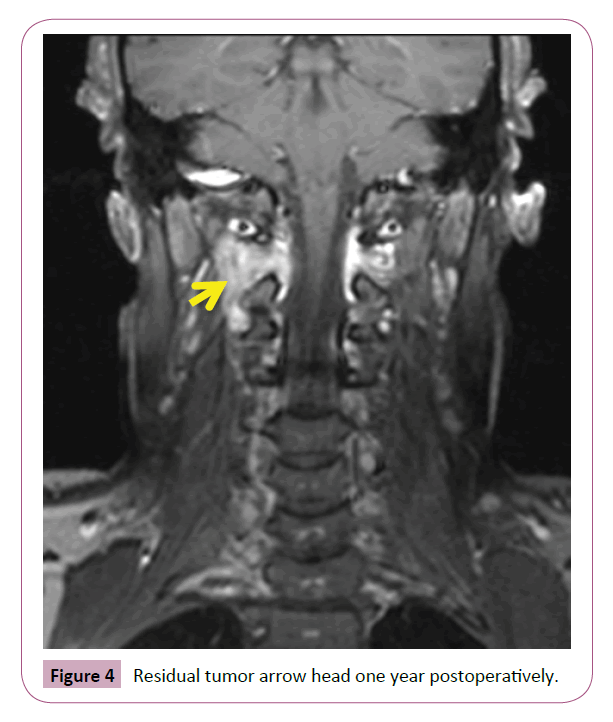Keywords
Inflammatory myofibroblastic tumor; Extradural; Schwannoma; Pregnancy
Introduction
Inflammatory myofibroblastic tumors (IMT) are soft-tissue masses of unidentified etiology, which has been described at various locations throughout the body. These lesions mostly affect the lung. The extrapulmonary localizations include the orbit, nasal sinuses, liver, spleen, pancreas, bowel, kidney, urinary bladder, testis, heart, lymphatic system, muscles and skin [1]. They rarely affect the spine [2]. Surgical excision is highly indicated to alleviate symptoms and to reach histopathological diagnosis. In some of the cases radiotherapy, chemotherapy and steroids are given as an adjuvant therapy. To the best of our knowledge, only seven cases of extradural inflammatory myofibroblastic tumor of the spine have been reported in the literature [2-7].
We present here an extremely rare location of inflammatory myofibroblastic tumor in the obliquus capitis inferior muscle between the levels of C1-C2 mimicking dumbbell-shaped schwannoma. After the surgical treatment complete resolution of the IMT is observed and did not show any recurrence even after the pregnancy. This unique case is discussed with relevant literature.
Case Report
A 28-year-old female patient was admitted giving a five-month history of pain located in her right occipital area. She had paresthesia and mild restriction of neck movement. She did not mention any history of fever, weight loss, and contact with a patient with tuberculosis, ingestion of raw milk or trauma. On her neurological examination, she had decreased sensation in right occipital area throughout C2 dermatome. On her laboratory investigation, hemoglobin level, white blood cell count, erythrocyte sedimentation rate, C-reactive protein level, and results of liver function tests were in normal range. Chest X-ray did not show any abnormalities.
Cervical spine computerized tomography (CT) showed dumbbellshaped isodense mass lesion in diameters of 3.4 × 3. 6 × 2.7 cm located in right obliquus capitis inferior muscle and extending into the epidural space between the level of C1 and C2 without bony involvement. After contrast injection this mass lesion was slightly enhanced in homogenously (Figure 1 A-B).
Figure 1: A-B: CT left without and right with contrast showed enhancement.
Magnetic resonance imaging (MRI) of the cervical spine showed the same dumbbell-shape mass lesion in the right higher cervical location. It was isointense to the spinal cord in T1 and hyper intense in T2-images. It showed in-homogenous enhancement after the gadolinium contrast. This lesion was showing indentation from the right epidural space into the cervical subarachnoid space leaving spinal cord intact (Figure 2 A-D).
Figure 2: A-D: Cervical spine MRI showed right dumbbell shape lesion extending from paraspinal to intraspinal extradural space. Isointense in axial T1W1 (a) hyperintense in axial T2W1 (b) compared to the spinal cord. (c) after gadolinium tumor showed strong inhomogeneous enhancement. (d) Coronal T1W1 with contrast.
She underwent operation because of both to relieve pain and to reach the tissue diagnosis. Hemi-laminectomy was done in the second cervical vertebrae and the extra-spinal part of the mass invading muscle was almost totally removed. Second cervical nerve root was sacrificed because of the tumoral invasion of the root.
Histopathological examination revealed proliferative spindle myofibroblastic cells with focal inflammation rich in plasma cells (Figure 3). Immune staining showed negative reaction to S-100 protein excluding neural origin and positive for vimentin confirming mesenchymal origin and positive for small muscle actin. This excludes schwannoma and confirms the diagnosis of IMT.
Figure 3: Photomicrographic view: lower left SMA positive and right lower vimentin positive.
Follow up CT scan showed gross total removal of the mass. The patient symptoms were completely resolved except numbness and returned back to her previous work as a physiotherapist. One year later MRI cervical spine showed residual tumor as shown in Figure 4. Three years later she became pregnant and her followup MRI after giving a birth showed that spine is free of tumor and no recurrence (Figure 5).
Figure 4: Residual tumor arrow head one year postoperatively.
Figure 5: Four years after excision: axial and coronal contrast MRI showed no residual tumor at C1-C2 level.
Discussion
Several synonyms including fibrous xanthoma, plasma cell granuloma, pseudosarcoma, lymphoid hamartoma, myxoid hamartoma, inflammatory myofibrohistiocytic proliferation, benign myofibroblastoma, inflammatory fibrosarcoma, xanthoma, histiocytoma, xanthogranuloma, postinflammatory tumor, and inflammatory pseudotumor are the names given to describe inflammatory pseudotumor since it is first described in 1954 [8]. It is a soft tissue lesion of unknown pathogenesis. The first case of intraspinal cervical IMT was reported by Eimoto et al. [9] in 1978. In 2002, the World Health Organization accepts the term inflammatory myofibroblastic tumor (IMT) [10]. In most documented cases of IMT, the etiology remains unknown.
IMTs are important because of the difficulty in differentiating them from true neoplasm clinically, radiologically and intraoperatively [11]. CT scan showed only soft tissue mass but no bony involvement and this goes with other reports where they found no bony involvement [12]. MRI findings were iso-intense in T1, hyper-intense in T2 and homogenously enhancing after contrast. The larger part of the tumor was paraspinal destructing right obliquus capitis inferior muscle and extending between C1/2 to involve the spinal canal in the epidural space giving the appearance of dumbbell shape schwannoma of C2 nerve root but without cord compression symptoms.
There are some reports referred to the origin of IMT from muscles. Paraspinal muscles in dorsal spine associated with rib fracture [13]. Isolated muscle involvement was reported in the anterior abdominal wall muscles [14,15]. In our patient the mass involved and infiltrated the obliquus capitis inferior muscle.
It has been reported involving various organs increasingly but intraspinal involvement of IMT is still very rare [2]. Intraspinal localization of the lesion can be primary or occur from a pulmonary IMT extension to the neighboring vertebrae [16]. Our patient presents with radicular symptoms involving C2 nerve root due to compression of this root in exiting foramen. This is the first case of IMT that mimic dumbbell schwannoma. Tumours with both intraspinal and extraspinal extension, connected through the intervertebral foramen, are called ‘dumbbell’ or ‘hourglass’ tumours. Most dumbbell tumours are neurogenic tumours, including schwannoma, neurofibroma, ganglioneuroma, and neuroblastoma; schwannomas account for about 70-90% of all dumbbell tumours.
Ozawa et al. [15] in 2007 studied 674 spinal cord tumors. 118 (18%) were dumbbell tumors, schwannomas constitute 69%. Of these 81 cases of schwannomas 18% were observed in the C-2 nerve root, thus having a higher incidence than those in the other nerve roots. These make us to consider our case preoperatively as a schwannoma. The rate of dumbbell tumors in the cervical spine was significantly higher than that of all spinal cord tumors. Malignant dumbbell shape tumors were found in 10 cases (8.5%) [16]. Spinal dumbbell-shaped schwannomas seem quite common, running to 10-15% of all spinal schwannomas [17- 19]. Some researchers consider the dumbbell tumor as a typical shape for spinal schwannoma [16,18]. We found only 7 cases of extradural spinal IMT reported in literature (Table 1) [2-7]. None of these cases have dumbbell shape appearance.
| Refer No. |
Year |
Age(years)/Sex |
Location |
T1W1 |
T2w1 |
Enhancement |
| Roberts et al. |
1997 |
58/F |
T9-T11 |
Iso |
Hypo |
NR |
| Gilliardet al. |
2000 |
45/M |
C3-T2 |
Iso |
NR |
Well |
| Robertset al. |
2001 |
39/F |
T5-T6 |
Iso |
Hypo |
NR |
| Seol et al. |
2005 |
44/M |
T1-T7 |
Iso |
Iso-Hyper |
Well |
| Sailler et al. |
2006 |
78/M |
C6-T3 |
NR |
Hypo |
Well |
| |
|
73/F |
T5-T7 |
NR |
Hypo |
Well |
| Katoet al. |
2012 |
63/M |
T5-T6 |
Iso |
Hypo- Hyper |
NR |
| Our case |
|
28/F |
C1-C2 |
Hypo |
Hyper |
Well |
T1W1: weighted images, T2W1: weighted images, F: Female, M: Male, Iso: Isointensity, Hypo: Hypointensity, Hyper: Hyperintensity, NR: Not Reported.
Table 1: Summary of literature with spinal epidural IMT.
Surgical excision is mandatory to relieve the symptoms and for cure and to reach histological diagnosis [20]. Our patient underwent surgical excision. Gross total resection for the paraspinal part and debulking of the epidural part. Although essentially considered benign lesions, IMTs may recur, metastasize or undergo malignant transformation 14. Systemic steroids, radiation therapy and immunosuppressive drugs are also given in IMT in other sites and lead to decrease in volume of the mass [1,3,21,22]. Our patient was followed for more than 48 months and the last MRI scan showed no evidence of recurrence. The recurrence rate varies from <2% for pulmonary lesions confined to 25% for extrapulmonary lesions [23,24].
Inflammatory myofibroblastic tumors were reported during pregnancy [1,25,26]. One present as an acute spinal cord compression [1] and another one as upper airway obstruction. It appeared that there is no association with pregnancy. Follow up MRI after pregnancy showed complete resolution of the tumor in our patient.
Immunohistochemistry; anaplastic lymphoma kinase (ALK) overexpression was associated with early multifocal recurrence [26]. This is a prognostic laboratory test. In our patient this test was not performed. But after more than four years with no recurrence it appears that it will be negative.
As a conclusion, inflammatory myofibroblastic tumors simulate neoplasm clinically and radiologically. Epidural IMT is rare but should be kept in the differential diagnosis of dumbbell shape schwannoma. Excision is mandatory for cure and histology diagnostic. Due to the limited number of reported cases, further research is necessary to better evaluate the efficacy of various treatment modalities. This is the unique case reported both in terms of its location originating from the musculus obliquus capitis and mimicking dumbbell–shape schwannoma and longterm follow-up during pregnancy.
References
- Boutarbouch M, Arkha Y, Rifi L, Derraz S, El Ouahabi A, et al. (2008)Intradural cervical inflammatory pseudotumor mimicking epidural hematoma in a pregnant woman: case report and review of the literature. SurgNeurol. 69:302-305.
- Roberts GA, Eldridge PR, Mackenzie JM (1997) Case report: inflammatory pseudotumour of the spine, with literature review. Br J Neurosurg. 11:570-572.
- Gilliard C, De Coene B, Lahdou JB(2000) Cervical epidural pseudotumor and multifocal fibrosclerosis: case report and review of the literature. J Neurosurg Spine. 93:152-156.
- Roberts G, Farrell M, Allcutt D (2001) Spinal inflammatory pseudotumours. Br J Neurosurg. 15:197-198.
- Sailler LJ, Porte L, Ollier SM, Astudillo LM, Couret BG, et al. (2006)Giant cell arteritis and spinal cord compression; an overlap syndrome? Mayo ClinProc81:89-91.
- Kato S, Murakami H, Demura S, Yoshioka K, Okamoto Y, et al. (2012) Epidural inflammatory pseudotumor in the thoracic spine in a patient with polymyalgia rheumatic. The Spine Journal. 12: e1-e4.
- Seol JH, Kim SS, Kim JE, Lee SH, Won JY, et al. (2005) Inflammatorypseudotumor in the epidural space of the thoracic spine: a case report and literature review of MR imaging findings. AJNR Am J Neuroradiol. 26:2667-2670.
- Umiker WO, Iverson L (1954)Postinflammatory tumors of the lung: report of four cases simulating xanthoma, fibroma, or plasma cell tumor. J Thorac Surg. 28:55-63.
- Eimoto T, Yanaka M, Kurosawa M, Ikeya F(1978) Plasma cell granuloma (inflammatory pseudotumour) of the spinal cord meninges: report of a case. Cancer 41:1929-1936.
- Fletcher CDM, Unni KK, Mertens F (2002) World Health Organization Classification of Tumours. Pathology and Genetics of Tumours of Soft Tissue and Bone. Lyon, France: IARC Press.
- Pfeifer L, Aqaimy A, Janka R, Boxberger F, Wein A, et al. (2011) Complete Long-Term Remission of an Inflammatory Pseudotumor under Corticosteroid Therapy. Case Rep Oncol. 4: 304-310.
- Ozawa H, ShoichiKokubun, Aizawa T, Hoshikawa T, Kawahara C(2007) Spinal dumbbell tumors: an analysis of a series of 118 cases. Journal of Neurosurgery: Spine 7: 587-593.
- Hong HY, Castelli MJ, Walloch JL (1990) Pulmonary plasma cell granuloma (inflammatory pseudotumour) with invasion of thoracic vertebra. Mt Sinai J Med 57:117- 121.
- Gezen F, Kahraman S, Canakci Z, Bedük A (2007) Review of 36 cases of spinal cord meningioma. Spine (Phila Pa 1976) 25:727-731.
- Nitter K (1976) Handbook of Clinical Neurology. In: Vinken PJ, BruynGWSpinalmeningiomas, neurinomas and neurofibromas and hourglass and tumors. Amsterdam: North-Holland. 20: 289-312.
- Sun WS, Jung YT, Kim SC, Sim JH (2002)A dumbbell-shaped thoraco-lumbar extradural ganglioneuroma: case report. J Korean NeurosurgSoc. 32:481-484.
- Al-Sarraj S, Wasserberg J, Bartlett R, Bridges LR (1995)Inflammatorypseudotumour of the central nervous system: clinicopathological study of one case and review of the literature. Br J Neurosurg. 9: 57-66.
- Coffin CM, Humphrey PA, Dehner LP (1995)Extrapulmonary inflammatory myofibroblastic tumor (inflammatory pseudotumor). A clinicopathologic and immunohistochemical study of 84 cases. Am J SurgPathol 19:859-872.
- Gilliard C, De Coene B, Lahdou JB, Boutsen Y, Noel H, et al.(2000)Cervical epidural pseudotumor and multifocal fibrosclerosis: case report and review of the literature. J Neurosurg Spine 93:152-156.
- Hausler M,Schaade L, Ramaekers VT,Doenges M, Heimann G, et al. (2003)Inflammatorypseudotumors of the central nervous system: report of 3 cases and a literature review. Hum Pathol 34:253-262.
- Amir R, Danahey D, Ferrer K, Maffee M (2002) Inflammatory myofibroblastic tumor presenting with tracheal obstruction in a pregnant woman. Am J Otolaryngol23:362-367.
- Hsieh PC, Lin CN (1995)Multicentric plasma cell granuloma of spinal cord meninges. ClinOrthop 317:188-192.
- Maze GL, Lee M, Schenker S (1999)Inflammatorypseudotumor of the liver and pregnancy. Am JGastroenterol. 94: 529-530.
- Lacoste-Collin L, Roux FE, Gomez-Brouchet A, Despeyroux ML, Uro-Coste E, et al. (2003) Inflammatory myofibroblastic tumor: a spinal case with aggressive clinical course and ALK overexpression. Case report. J Neurosurg. 98:218-221.
- YagciMA, Sezer A, Yeldan E, Coskun I, Usta U, et al.(2010) Inflammatory myofibroblastic tumor presenting as an abdominal wall mass in an adult patient. J cancer Res Ther. 6: 224-226.
- Pratap A,Tiwari A, AgarwalB, Pandey SR, Paudel G, et al. (2007) Inflammatory Myofibroblastic Tumor of the Abdominal Wall Simulating Rhabdomyosarcoma: Report of a Case. Surg Today. 37:352-355.






